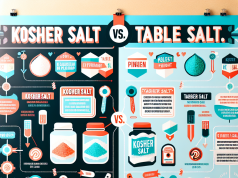Contents
White Pepper: A Mild and Subtle Spice for Your Recipes
White pepper, also known as the “King of Spices,” is a versatile spice that adds a delicate flavor to a wide range of culinary creations. Derived from the dried and ripe berries of the Piper nigrum plant, it is a popular choice in many cuisines around the world.
Unlike its counterpart, black pepper, white pepper is made from berries that have been soaked and then the dark outer layer is removed, leaving behind a smooth, ivory-colored seed. This process gives white pepper a milder and subtler taste, making it a perfect choice for dishes where a touch of spiciness is desired without overpowering the other flavors.
White pepper is often used in light-colored dishes, such as creamy soups, sauces, and mashed potatoes, as its color is less visible compared to black pepper. It can also be sprinkled over seafood, salads, and grilled vegetables to add a zesty note without altering the appearance of the dishes.
In addition to its flavor-enhancing properties, white pepper is known for its potential health benefits. It is believed to possess antioxidant and antimicrobial properties, aiding in digestion and promoting gut health. However, it is worth noting that moderation is key, as excessive consumption of white pepper may cause gastrointestinal discomfort in some individuals.
To incorporate white pepper into your recipes, you can either opt for whole white peppercorns and grind them using a pepper mill or use pre-ground white pepper for convenience. Regardless of your choice, it is recommended to store white pepper in airtight containers away from heat and light to retain its flavor and potency.
Next time you want to add a subtle yet delicious touch to your culinary creations, consider reaching for white pepper. Its mildness and versatility make it an excellent spice to have in your pantry, allowing you to elevate the flavors of various dishes with ease.
White Pepper: A Mild and Subtle Spice for Your Recipes
What is White Pepper?
White pepper is a popular spice derived from the dried ripe berries of the Piper nigrum plant. It is made by removing the outer layer of the peppercorn, leaving only the inner seed. Unlike black pepper, which is made from the whole fruit, white pepper has a milder flavor and a subtle heat.
Flavor Profile
White pepper offers a unique taste that can elevate your culinary creations. It is known for its earthy, slightly spicy, and hot flavor. Compared to black pepper, white pepper has a less pungent and more delicate taste. Its subtle heat adds depth and complexity to various dishes without overpowering their natural flavors.
Benefits of Using White Pepper
1. Enhances Digestion: White pepper has been traditionally used to aid digestion and alleviate digestive issues.
2. Rich in Antioxidants: It contains antioxidants that help combat free radicals in the body, potentially reducing the risk of chronic diseases.
3. Anti-inflammatory Properties: The active compound in white pepper, called piperine, possesses anti-inflammatory properties that may benefit overall health.
Uses in Culinary Delights
White pepper is widely used in both Western and Asian cuisines. Some popular uses include:
- Seasoning soups, stews, and sauces.
- Adding subtle heat to creamy dishes like mashed potatoes and pasta sauces.
- Incorporating into spice rubs for meats and vegetables.
- Enhancing the flavor of marinades and dressings.
- Completing the taste of certain seafood dishes.
Substituting White Pepper
If you’re out of white pepper and need a substitute, you can use a smaller amount of black pepper, but be aware that it will have a stronger flavor. Alternatively, you can use other mild spices like ground celery seeds or ground white mustard seeds for a similar effect.
Where to Buy White Pepper
You can find white pepper in most grocery stores, supermarkets, or specialty spice shops. Additionally, it is available for purchase online, ensuring accessibility no matter where you live!
In Summary
White pepper is a mild and subtle spice that adds a unique depth of flavor to your recipes. With its earthy and slightly spicy taste, it is a versatile ingredient that can enhance various dishes. From soups and sauces to meat rubs and dressings, white pepper can help take your culinary creations to the next level.
Interested in experimenting with more spices and flavors? Check out our blog post on Understanding and Utilizing the Power of Spices.
Frequently Asked Questions about White Pepper
What is white pepper?
White pepper is a spice derived from the dried seeds of the Piper nigrum plant. It is made by removing the outer layer of the black peppercorns, leaving behind the inner seed. The seeds are then sun-dried, which results in the characteristic white color.
What is the taste profile of white pepper?
White pepper has a milder and subtler flavor compared to black pepper. It has a slightly fermented, earthy taste with hints of spice. It offers a unique aroma that is less pungent than black pepper.
How is white pepper used in cooking?
White pepper is commonly used in various cuisines for its ability to add flavor and aroma to dishes without altering the visual appearance. It is often preferred in light-colored or cream-based dishes, as it does not have the dark specks that black pepper would leave behind. It works well in soups, sauces, seafood, chicken, and vegetable recipes.
Can white pepper be used as a substitute for black pepper?
While white pepper can be used as a substitute for black pepper in most recipes, it is important to consider the taste difference. White pepper has a milder flavor, so you may need to use a slightly larger quantity to achieve the same level of spiciness. It is best to taste-test and adjust accordingly.
Does white pepper have any health benefits?
White pepper, like black pepper, contains a compound called piperine, which has been associated with potential health benefits. It may help improve digestion, increase nutrient absorption, and possess antioxidant properties. However, further research is needed to fully understand and validate these potential health benefits.
White Pepper vs Black Pepper
White Pepper: What Sets it Apart?
White pepper is a type of pepper that is derived from the same flowering vine as black pepper, known as Piper nigrum. What makes white pepper distinct is the specific process it undergoes during preparation. White pepper is made from fully ripe pepper berries, which are soaked in water and then the outer layer is removed, leaving only the seed. This seed, or white peppercorn, is then dried, resulting in a milder flavor compared to black pepper.
Black Pepper: A Staple Spice with Bold Flavor
Black pepper is widely used and loved for its bold and pungent flavor. The berries are harvested before they fully ripen, and then they are dried, which gives black pepper its characteristic dark color. Due to its strong taste, black pepper is often utilized in savory dishes, marinades, and spice blends.
Choosing Between White Pepper and Black Pepper
The choice between white pepper and black pepper mostly depends on the desired flavor profile of the dish you are preparing. If you prefer a milder taste that subtly enhances the dish without overpowering it, white pepper is a great option. It is commonly used in light-colored or creamy dishes where specks of black pepper might be undesirable.
On the other hand, if you are aiming for a more robust and spicy flavor, black pepper should be your go-to. Its strong taste adds depth to dishes, making it perfect for hearty soups, grilled meats, and other savory recipes.
Both white pepper and black pepper offer distinct qualities that can be appreciated in various culinary creations. Their unique characteristics make them suitable for different dishes, so it ultimately comes down to personal preference and the specific recipe requirements.
To learn more about pepper, you can visit the Wikipedia page on Black Pepper.
White Pepper: A Mild and Subtle Spice for Your Recipes
– Delicate and aromatic spice
– Derived from ripe peppercorns
– Mild flavor with a hint of heat
– Commonly used in light-colored dishes
– Adds depth and complexity to soups and sauces
– Enhances the taste of seafood and poultry
– Versatile ingredient in both sweet and savory recipes
– Often used in Asian and European cuisines
– Adds a subtle heat without overpowering other flavors
– Ideal for those who prefer a milder spiciness.








































